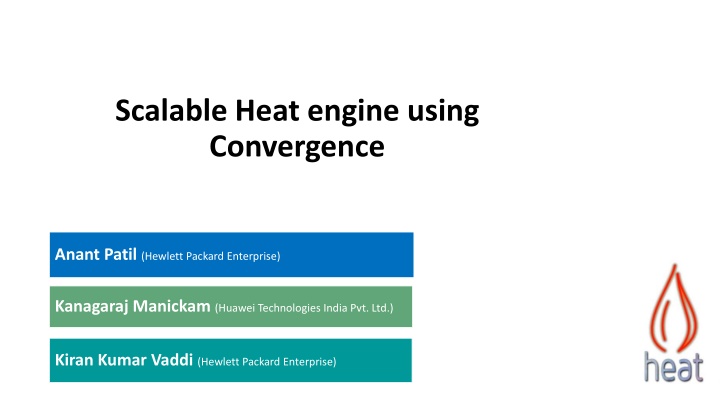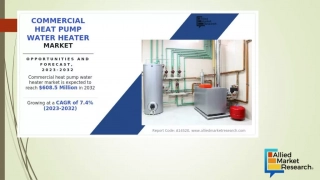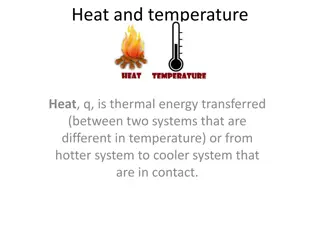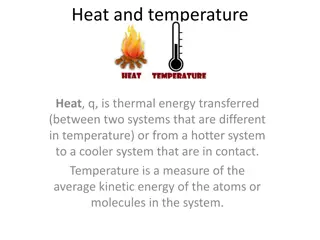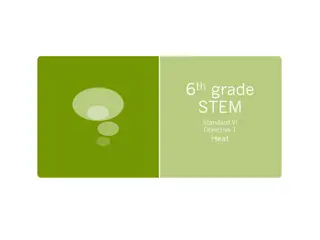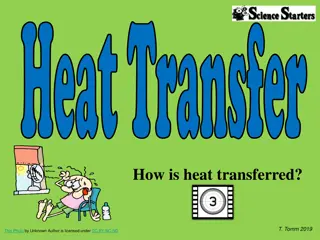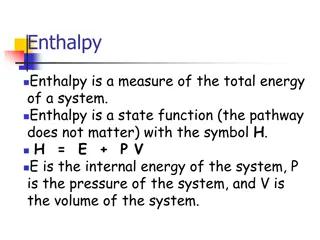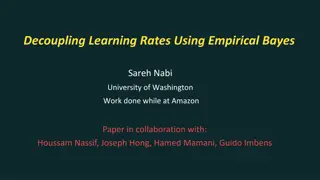Overview of Scalable Heat Engine using Convergence
Anant Patil and Kanagaraj Manickam discuss a scalable heat engine using convergence architecture, offering insights into design evolution, comparison, and progress. The presentation covers an orchestration service to manage cloud applications, including modeling, deployment, scalability, configuration, and tracking lifecycle operations. The template and resources for capturing the declarative model of cloud applications are also highlighted.
Download Presentation

Please find below an Image/Link to download the presentation.
The content on the website is provided AS IS for your information and personal use only. It may not be sold, licensed, or shared on other websites without obtaining consent from the author.If you encounter any issues during the download, it is possible that the publisher has removed the file from their server.
You are allowed to download the files provided on this website for personal or commercial use, subject to the condition that they are used lawfully. All files are the property of their respective owners.
The content on the website is provided AS IS for your information and personal use only. It may not be sold, licensed, or shared on other websites without obtaining consent from the author.
E N D
Presentation Transcript
Scalable Heat engine using Convergence Anant Patil (Hewlett Packard Enterprise) Kanagaraj Manickam (Huawei Technologies India Pvt. Ltd.) Kiran Kumar Vaddi (Hewlett Packard Enterprise)
About Presenters Anant Patil Software Engineer @ HPE, Bangalore, India OpenStack Heat contributor Having 8+ years of experience in Network Management Software (HP NNMi). And Having 3+ years of experience in OpenStack Cloud. IRC: ananta Kanagaraj Manickam Sr. System Architect @ Huawei, Bangalore, India Core-reviewer @ Heat, Openstack. Having 8+ years of experience in HP data-center Server, Storage management and automation products. And Having 3+ years of experience in OpenStack Cloud. Establishing new service namos OpenStack Manager) Kiran Kumar Vaddi Architect @ Hewlett Packard Enterprise, Bangalore, India Having 14 years of experience in System management software and having 3+ years of experience in building private cloud solution using OpenStack. 2
Agenda Brief Overview of Heat & Mitaka Updates Convergence: The New architecture Convergence Design Evolution Convergence Design Comparison Convergence Observer Convergence Progress Q & A
Cloud application Sample Word-press application Wordpress Web-server Wordpress Web-server Load- balancer Wordpress Web-server Db-server Configuration Storage
Introduction An orchestration service to create and manage the lifecycle of cloud application How to model the cloud application deployment (in YAML/JSON)? Heat provides Template (HOT & AWS CFN) How to model the cloud application element like instances, volumes,? Heat provides Resource (as resource plug-in) How to create and manage the cloud application? Heat provides Stack How to manage the cloud application scalability? Heat provides Auto-scaling How to deploy the cloud application? Heat provides Software-Deployment How to configure the cloud application? Heat provides Software-Configuration How to track the progress of life-cycle operations ? Heat provides Events
Template and resources Capture the declarative model of cloud application my_instance: type: OS::Nova::Server properties: key_name: kp1 image: cirros-0.3.3 flavor: m1.small networks: [private] heat_template_version: 2015-04-15 description: > Cirros instance created with 10 GB volume parameters: key_name: type: string description: Name of an existing key pair for instance constraints: - custom_constraint: nova.keypair description: Must name a public key (pair) known to Nova flavor: image: network: vol_size: resources: my_instance: . my_vol: . vol_att: . my_vol: type: OS::Cinder::Volume properties: size: 10 GB /dev/vdb 10 GB vol_att: type: OS::Cinder::VolumeAttachment properties: instance_uuid: { get_resource: my_instance } volume_id: { get_resource: my_vol } mountpoint: /dev/vdb outputs: instance_networks: description: The IP addresses of the deployed instance value: { get_attr: [my_instance, networks] }
Liberty vs Mitaka Blueprints Mitaka: 47 Completed Blueprints Liberty: 53 Completed Blueprints
Liberty vs Mitaka Commits Mitaka: 1070 Commits Liberty: 1399 Commits
Convergence The new architecture
Motivation Clouds are noisy Build capacity in Heat to deal with failures in physical work Robustness Heat engine restarts/failures fail stack Stack provisioned in singe heat-engine process Large stacks can exceed heat engine s capacity Convergence Scale Stacks should scale to the limits of external components Take right action when user intervention not needed Users should be able to update stack at any time Existing stacks should keep working Availability/ Usability Efforts to address all these concerns started under name convergence
Convergence phases Phase 1 Phase 2 Phase 3 Design changes in engine Observer Continous observer Persist graph in DB Observe before update Act based on changes in reality Workers in each engine Poll or use notification system Fault tolerant heat engines? RPC cast resource task In process polling to observe- Engine restarts Resources propagate on their own and-notify Engine processes crashing User s choice to enable it
Phase 1: Design evolution Legacy engine Stack-1 Heat-Engine-1 AMPQ Heat-API Template Stack-2 DB Heat-Engine-2 Heat-Engine-3 Stack-3 Z Stacks are distributed across available engines D D W X Y C C K J G H I A B A B E F A B C D Stack-3 Stack-1 Stack-2
Phase 1: Design evolution Legacy engine Stack-1 Heat-Engine-1 AMPQ Heat-API Template Stack-2 DB Heat-Engine-2 G H Heat-Engine A B C D E F Stack-3 Z Stacks are distributed across available engines Entire stack is handled by one engine Even when other engines are available they will not be utilized for stacks that are in progress D D W X Y C C K J G H I A B A B E F A B C D Stack-3 Stack-1 Stack-2 Legacy engine: Large stacks can exceed capacity of one engine process
Phase 1: Design evolution Convergence engine A F C B Heat-Engine-1 D A B DB worker Heat-Engine-2 Template Heat-API AMPQ B A E Heat-Engine-3 Schedule A, B Stack-1 Z D D X Y 1. Engine processes start listening on worker topic 2. Parse the template and store graph, resources 3. Resources are distributed among heat engine processes 4. Resources acquire resource lock and proceed C C K J G H I A B E F A B C D A B Stack-1 Stack-2 Stack-3
Phase 1: Design evolution Convergence engine A F C B Heat-Engine-1 Schedule C D A B DB worker Heat-Engine-2 Template Heat-API AMPQ B A E Heat-Engine-3 Z D D X Y 1. A is done, cannot propagate C 2. B is done, propagates C C C K J G H I A B E F A B C D A B Stack-1 Stack-2 Stack-3
Phase 1: Design evolution Convergence engine I C Heat-Engine-1 J G DB worker Heat-Engine-2 Template Heat-API AMPQ H C K Heat-Engine-3 A B Z A B D D W X Y C C K J G H I A B A B A B C D E F Stack-1 Stack-2 Stack-3 A B C D E Done Resources F Stacks
Phase 1: Design evolution Convergence engine I Heat-Engine-1 W D DB worker Heat-Engine-2 Template Heat-API AMPQ D K Heat-Engine-3 C C A B Z A B D D W X Y C C K J G H I A B A B A B C D E F J G H Stack-1 Stack-2 Stack-3 A B C D E Done Resources F Stacks
Phase 1: Design evolution Convergence engine W Heat-Engine-1 X DB worker Heat-Engine-2 Template Heat-API AMPQ Y Heat-Engine-3 D D C C A B Z A B D D W X Y C C K J G H I A B A B A B C D E F K J G H I Stack-1 Stack-2 Stack-3 A B C D E Done Resources F Stacks
Phase 1: Design evolution Convergence engine Heat-Engine-1 DB worker Heat-Engine-2 Template Heat-API AMPQ Z Heat-Engine-3 D D C C A B Z A B D D W X Y C C K J G H I W X Y A B A B A B C D E F K J G H I Stack-1 Stack-2 Stack-3 A B C D E Done Resources F Stacks
Phase 1: Design evolution Convergence engine Heat-Engine-1 DB worker Heat-Engine-2 Template Heat-API AMPQ Heat-Engine-3 D D C C A B Z A B D D W X Y Z C C K J G H I W X Y A B A B A B C D E F K J G H I Stack-1 Stack-2 Stack-3 A B C D E Done Resources F Stacks
Phase 1: Design Comparison Legacy Convergence More granular resource locks Stack wide Locking In DB In memory Graph/Progress Info Stack resource tasks distributed among heat engine processes Stack runs on one engine process Load distribution Yes No Concurrent Update
Phase 2: Observer Why Observer is required? After successful deployment of a stack, the following problem exist if any resource fails 1. No mechanism to know current state of stack resources and notify user 2. If a resource in the stack is unavailable there is no way to sync the resource back to normal 3. Any updates to such a stack can fail
Phase 2: Observer Stack update <stack id> <template with new resource> AMPQ Template Heat-API D needs update ? n DB state matches template data, no update required C C A B 1. Get resource inform DB Stack Heat-Engine DB Heat-Engine Heat-Engine D C A B Stack
Phase 2: Observer Stack update <stack id> <template with new resource> AMPQ Template Heat-API D n Creation of resource n will fail since dependent resource C is not available C n A B Stack Heat-Engine DB Heat-Engine Heat-Engine D C A B Stack
Phase 2: Observer Stack update <stack id> <template with new resource> AMPQ Template Heat-API D needs update ? n C 2. Get live state of the resource DB state matches template data, no update required C A B 1. Get resource inform DB Stack Heat-Engine DB Observer Heat-Engine Heat-Engine 3. Merge DB data with live state 4. Compare merged data with template data D C A B 5. Bring resource in sync Stack
Convergence progress 5 Newton Make default in newton - 1 Stack-cancel-update & esoteric features Address performance issues Complete observe-on- update Convergence Functional tests Phase 3 HA using DLM Continous observer? 4 Mitaka Phase 2 BP for observe- on-update Gate job for convergence made mandatory Patch to keep testing TripleO Testing and bug fixing Fixing all intermittently failing functional tests Lot of patches for observe-on-update 3 Liberty Implement phase 1 BPs Convergence graph computaion Light weight stack Workers, RPC cast Resource level locks and retries Concurrent workflow Scenario tests Experimental convergence gate job 2 Kilo PoCs and evaluations in Mid Kilo Decided to do in phases Phase 1 BPs submitted Implement DB changes Implement Convergence message bus 1 Juno Convergence initial BPs (filed towards the end) 26
Convergence Vs Legacy (Time taken) 700 606.59 600 551.819 489.668 500 433.249 Time taken (secs) 400 374.087 357.467 330.011 318.551 289.103 300 262.93 261.175 234.788 208.85 206.5 187.919 200 168.09 164.795 Convergence Legacy 147.715 120.184 116.995 32 Heat engine processes 48 CPU 256 GB RAM 1 TB HDD 100 0 0 0 0 0 0 0 0 0 0 0 50 100 150 200 250 300 350 400 450 500 Stack Size https://github.com/asalkeld/convergence-rally
Convergence comparison (Number of engine processes vs Time Taken) 500 437.749 450 400 381.342 357.467 348.019 350 330.011 301.82 Time taken (secs) 289.103 300 269.333 261.175 234.788 250 224.603 206.5 191.555 187.919 200 8 Processes 32 Processes 164.667 168.09 147.715 138.482 150 120.184 112.36 100 50 0 0 0 0 0 0 0 0 0 0 0 50 100 150 200 250 300 350 400 450 500 Stack Size
Legacy Engine comparison (Number of engine processes vs Time Taken) 700 614.945 606.59 600 562.262 551.819 495.367 489.668 500 441.153 433.249 Time taken (secs) 380.259 374.087 400 323.835 318.551 300 265.404 262.93 211.576 208.85 200 162.229 164.795 legacy 8 CPUs 116.554 116.995 legacy 32 CPUs 100 0 0 0 0 0 0 0 0 0 0 0 1 2 3 4 5 6 7 8 9 10 Stack Size
Convergence Blueprints Activity Blueprint convergence Blueprint convergence-engine Blueprint convergence-continuous-observer Blueprint convergence-observer Release Juno Juno Juno Juno Owners Clint Byrum & Mike Spreitzer Clint Byrum Clint Byrum Clint Byrum Anant Patil, Rakesh HS, Sirushti Murugesan, Ishant Tyahi, Unmesh Gurjar, Vishnusaran Murugan, Kanagaraj Manickam Zane Bitter Zane Bitter Peter Razumovsky Sergey Kraynev Kanagaraj Manickam Sergey Kraynev Anant Patil Angus Salkeld Rakesh H S Sirushti Murugesan Rakesh H S Sirushti Murugesan Ishant Tyagi Anant Patil Angus Salkeld Kanagaraj Manickam Heat Community Heat Community Convergence-engine PoC on top of upstream heat codebase Convergence-engine PoC Convergence-engine blueprint is converted into small blueprints based on above PoC Blueprint convergence-config-option Blueprint convergence-resource-table Blueprint convergence-message-bus Blueprint convergence-push-data Blueprint convergence-stack-data Blueprint convergence-concurrent-workflow Blueprint convergence-graph-progress Blueprint convergence-lightweight-stack Blueprint convergence-prepare-traversal Blueprint convergence-check-workflow Blueprint convergence-resource-locking Blueprint convergence-rollback Blueprint convergence-resource-replacement Blueprint convergence-resource-operations Enable Convergence-engine-functional testing in zuul gate Convergence-engine Functional-testing and bug fixing Juno, Kilo Kilo Kilo Kilo Kilo Kilo Kilo Kilo Liberty Liberty Liberty Liberty Liberty Liberty Liberty Liberty Liberty Liberty Liberty 15
Get involved IRC The developers use IRC in #heat on Freenode for development discussion. Meetings Meetings are held on IRC in #openstack-meeting on Freenode. See the Heat agenda page for times and details. Mailing list Discussions about Heat happens on the openstack-dev mailing list. Please use the tag [Heat] in the subject line for new threads https://wiki.openstack.org/wiki/Heat
